US Dollar Strength: Is It Time to Take a Look at Procter & Gamble (PG)?

The US dollar has recently risen sharply and is showing an upward trend. ICE US Dollar Index 1.4%Former President Donald Trump’s presidency accelerated the recent election results. The rally, which has strengthened the dollar against major currencies including the euro, yen and yuan, has reignited investor interest in how a stronger dollar could affect multinational giants. One of the companies that is attracting attention is Procter & Gamble (PG)It is a leading consumer goods manufacturer with extensive international operations.
Procter & Gamble (P&G), known for products ranging from Tide and Pampers to Gillette and Crest, generates significant revenue outside the United States, making it particularly vulnerable to currency fluctuations. A rising dollar could challenge and shape P&G’s performance in ways that investors should closely examine, especially if this trend continues.
The impact of a strong dollar on multinational corporations such as Procter & Gamble.
A strong dollar tends to be a burden for multinational companies because it erodes the value of their foreign profits when converted back into U.S. dollars. For companies like P&G Net sales decreased by 1% Exchange rate fluctuations compared to the previous year were a notable factor in the first quarter of 2025. P&G’s organic sales, excluding currency impact, increased 2% in the quarter, underscoring that currency-neutral performance remains a strategic focus for the company.
Historically, P&G’s financials have shown mixed results during periods of dollar strength. Strong brand loyalty and premium products often allow for price adjustments, but foreign exchange headwinds still tend to compress margins. For example, P&G’s core EPS increased 5% in the first quarter of 2025 despite the dollar impact. This foreign exchange-adjusted growth not only highlights the company’s resilience, but also indicates the sensitivity of its earnings to currency fluctuations.
Procter & Gamble’s global revenue
P&G’s global sales history shows that the company is exposed to currency risk. More than half of its total revenue comes from outside North America, with significant sales coming from markets such as Europe, Asia Pacific, and Latin America. This extensive international presence makes P&G vulnerable to dollar appreciation. This is because each overseas sale loses value when converted to a stronger dollar. For example, the beauty sector, which relies heavily on markets such as China, reported: down 5% Net sales were lower in the first quarter of FY2025, in part due to currency issues.
P&G’s currency-neutral core EPS, a foreign exchange-adjusted measure, increased only 4%, slightly lower than overall core EPS growth. This performance suggests that P&G is doing well across the region, but that currencies remain an external factor that could delay revenue growth to some extent.
Strategic response to exchange rate issues
P&G has taken proactive steps to mitigate foreign exchange risk through target pricing strategies and cost management. In regions facing strong exchange rate headwinds, companies have often relied on price increases to offset the impact of exchange rates. In the first quarter of 2025, pricing contributed 1% to the company’s 2% organic sales growth, which P&G attributed to strategic pricing adjustments across various markets.
To further combat the impact of the strong dollar, P&G is leveraging productivity savings, and first quarter results are as follows: 230 basis points Increased productivity throughout your operations. These actions allowed P&G to reinvest in brand-building activities and manage costs amid currency fluctuations. Additionally, the Company’s restructuring in certain markets, including Argentina, where economic volatility has a significant impact on its operations, reflects its approach to reduce its exposure to hyperinflationary regions.
Investment Considerations
For investors, evaluating P&G given the strength of the dollar requires evaluating both its valuation and dividend yield. P&G’s stock currently trades at a non-GAAP forward price-to-earnings ratio (P/E) of 23.8x, which is higher than the industry average of 17.6%. This reflects our strong brand portfolio and consistent performance. On the dividend side, P&G’s 2.4%+ yield is attractive to income-focused investors as the company remains committed to dividend growth and share buybacks. The company’s dividend has grown about 6% over the past five years.
P&G outperformed its peers in terms of organic sales growth and productivity metrics while maintaining stable core operating margins despite currency headwinds. This stability makes P&G a favorable choice for investors seeking resilience even if short-term earnings fluctuate due to dollar fluctuations.
What should investors do?
Due to the high level of the dollar and P&G’s significant international exposure, potential investors may view P&G as a steady choice even if expectations for earnings growth are tempered by currency effects. Those who already own the stock may be wise to maintain their positions, considering the company’s dividend reliability and strategic currency hedges.
For prospective investors, P&G’s focus on core brands, pricing flexibility, and increased productivity could make it a viable option for a diversified portfolio, especially if the dollar stabilizes in the coming months.



